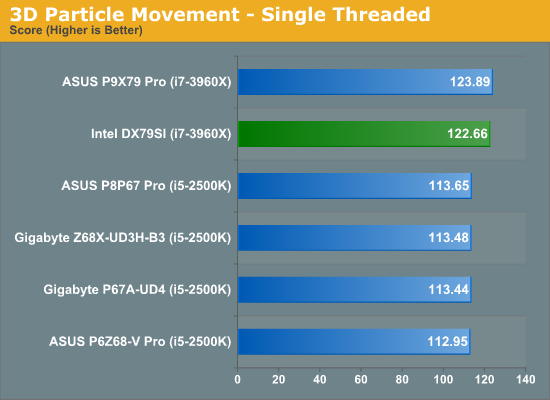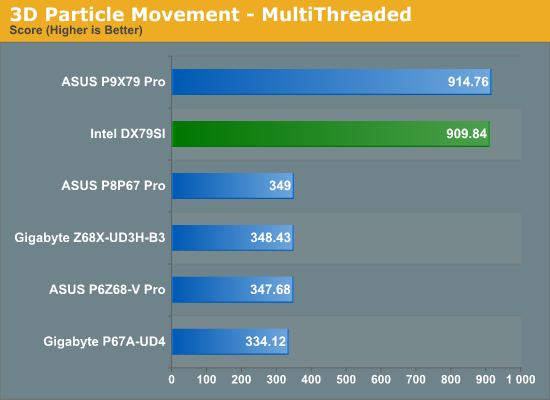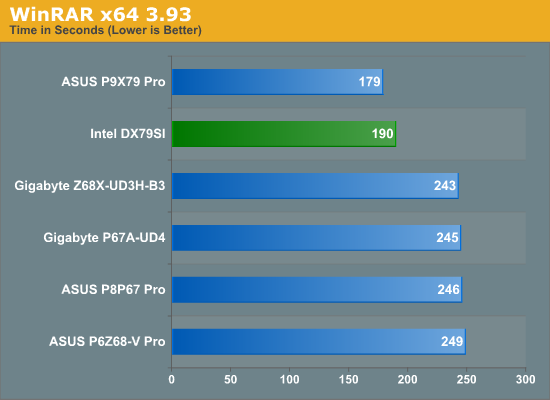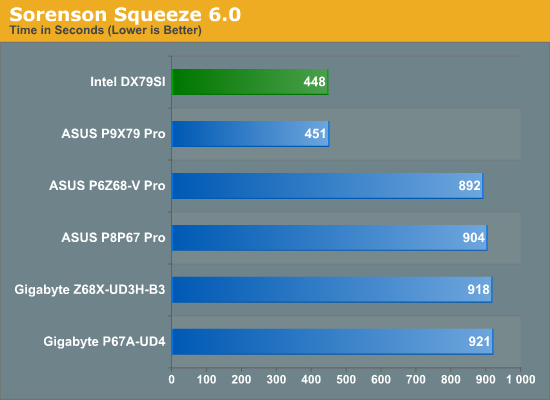Intel DX79SI Review: The Default X79?
by Ian Cutress on November 18, 2011 1:10 AM EST- Posted in
- Motherboards
- Intel
- X79
3D Movement Algorithm Test
The algorithms in 3DPM employ both uniform random number generation or normal distribution random number generation, and vary in various amounts of trigonometric operations, conditional statements, generation and rejection, fused operations, etc. The benchmark runs through six algorithms for a specified number of particles and steps, and calculates the speed of each algorithm, then sums them all for a final score. This is an example of a real world situation that a computational scientist may find themselves in, rather than a pure synthetic benchmark. The benchmark is also parallel between particles simulated, and we test the single thread performance as well as the multi-threaded performance.


As we saw with the ASUS board, the 3960X with its higher multiplier in ST and 12 threads in MT dominates our 3DPM results. However, the DX79SI does come in lower than the P9X79 Pro on both accounts.
WinRAR x64 3.93 - link
With 64-bit WinRAR, we compress the set of files used in the USB speed tests. WinRAR x64 3.93 attempts to use multithreading when possible.

Given the regularity within previous chipsets on our WinRaR test, it is perhaps surprising that the DX79SI performs a whole 11 seconds slower than the P9X79 Pro. Despite this, the results were repeatable, indicating that the boards detect differently how many CPUs are running and turbo core appropriately.
FastStone Image Viewer 4.2 - link
FastStone Image Viewer is a free piece of software I have been using for quite a few years now. It allows quick viewing of flat images, as well as resizing, changing color depth, adding simple text or simple filters. It also has a bulk image conversion tool, which we use here. The software currently operates only in single-thread mode, which should change in later versions of the software. For this test, we convert a series of 170 files, of various resolutions, dimensions and types (of a total size of 163MB), all to the .gif format of 640x480 dimensions.

As noted in previous X79 testing, FastStone seems not to benefit from the faster LGA2011 CPU, and nothing separates the X79 boards.
Sorenson Squeeze 6.0 - link
Sorenson Squeeze is a professional video encoder, complete with a vast array of options. For this test, we convert 32 HD videos, each a minute long and approximately 42 MB in size, to WMV 512KBps format. Squeeze can encode multiple videos at once, one for each thread.

As our Squeeze test uses all the threads all the time (unlike WinRar), we see a relatively small difference in the results here.










60 Comments
View All Comments
coldfiredragon - Friday, November 18, 2011 - link
Oh ya I have been using them exclusivly since arround 99, with their 440BX board for Pentium 3's. I love them, solid dependible I have never had to RMA one.The0ne - Friday, November 18, 2011 - link
I used them exclusively for work back them. By this I mean I tested and qualify the boards and CPU's for our products. and to deploy in the mfg environment. The key characteristic is, of course, reliability.Not sure why the person above doesn't know this :) Maybe this link can help,
http://knowyourmeme.com/memes/futurama-fry-not-sur...
vol7ron - Sunday, November 20, 2011 - link
I've never actually owned the Intel branded boards. I think the primary reason is that I like the potential to overclock and whenever there were articles of this, Intel either locked their settings, or their boards didn't overclock all that well (either through voltage regulation or thermal problems).Any comments regarding this?
Bozo - Saturday, November 19, 2011 - link
I have been using Intel motherboards since the mid 1990's at work. If you want stability and reliability, Intel is the way to go.mino - Sunday, November 20, 2011 - link
Most of the time ... Had a lot of 50 PC's with Intel mobo's go POOF within 2Q after getting our of warranty. ... THoug those were NetBurst times. KInda expected they will "Burst" :).On a serious note, business-class Intel Mobo's are one of the best as far as reliability goes.
Though, over the past 5 years since reliability actually became a marketing term in the mobo business, the gap as it was in the 90's and starting 2000's is no longer there.
acompsys - Wednesday, November 30, 2011 - link
True...http://www.youtube.com/watch?v=z0uXWmlMOgg
Googer - Sunday, November 20, 2011 - link
Intel has been in the motherboard business for about 17-18 years or so. I still have my old Intel Socket 370 FCPGA2 Motherboard from 10 years ago.Googer - Sunday, November 20, 2011 - link
A lot of OEMs use intel as their Board maker. Dell used (or still uses?) a Custom Intel board in their machines, Emachines used a rebadged off the shelf intel board in their cases too.mino - Monday, November 21, 2011 - link
OEM's not so much. Whiteboxers mostly, along with several "wanna-be's", Dell included in its early years.PrezWeezy - Sunday, November 20, 2011 - link
Intel has been making their own motherboards for a very long time. They aren't usually known for being the fastest boards around, but they are damn solid. Very very few failures comparitively, and they run forever. They also tend to be very expensive.